Effects
of Ionizing Radiation
 When ionising radiation (ultra-violet rays, gamma rays, X-rays and radioactive materials) collides with molecules in living cells it can damage them.
When ionising radiation (ultra-violet rays, gamma rays, X-rays and radioactive materials) collides with molecules in living cells it can damage them.
 Ionising radiation is everywhere - see background radiation - but in certain environments it is much higher than background and can be dangerous.
Ionising radiation is everywhere - see background radiation - but in certain environments it is much higher than background and can be dangerous.
 The damage done on exposure to ionising radiateion can cause mutation or cell death. In most cases the damage is not a big problem - it just causes that cell to malfunction or become inoperative. But if the DNA in the nucleus of a cell is damaged in such a way as to be still viable, the cell may become cancerous. In this case the cell divides rapidly and causes serious health problems.
The damage done on exposure to ionising radiateion can cause mutation or cell death. In most cases the damage is not a big problem - it just causes that cell to malfunction or become inoperative. But if the DNA in the nucleus of a cell is damaged in such a way as to be still viable, the cell may become cancerous. In this case the cell divides rapidly and causes serious health problems.
 The greater the dose of radiation, the greater the probability that a cell will become cancerous. That is why older people (who have had longer exposure to ionising radiation over their lives) are more likely to get cancer than children.
The greater the dose of radiation, the greater the probability that a cell will become cancerous. That is why older people (who have had longer exposure to ionising radiation over their lives) are more likely to get cancer than children.
 However, very high doses of radiation can kill cells.
However, very high doses of radiation can kill cells.
 High doses of radiation are used to kill cells - they are aimed precisely at specific areas of the body in cancer treatments - see here
High doses of radiation are used to kill cells - they are aimed precisely at specific areas of the body in cancer treatments - see here
 Radiation is also used to kill harmful bacteria and other micro-organisms on food stuffs and medical equipment - see here.
Radiation is also used to kill harmful bacteria and other micro-organisms on food stuffs and medical equipment - see here.
 The hazard symbol is shown on containers of radioactive substances to warn of the danger.
The hazard symbol is shown on containers of radioactive substances to warn of the danger.
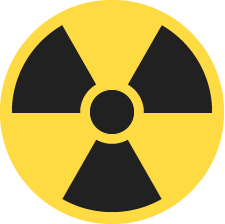

 There are two types of
effect from exposure to ionizing radiation:
There are two types of
effect from exposure to ionizing radiation:
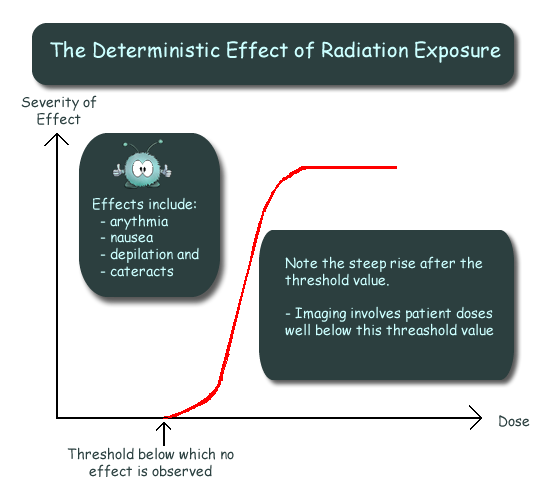
 Deterministic effects (see graph above) have
a threshold.
Deterministic effects (see graph above) have
a threshold.
 They include arythmia (changes in heart rhythm - iregular heartbeat) , nausea (feeling sick), depilation (losing hair) and cateracts (clouding of the cornea in the eye).
They include arythmia (changes in heart rhythm - iregular heartbeat) , nausea (feeling sick), depilation (losing hair) and cateracts (clouding of the cornea in the eye).
 If the dose is low deterministic effects can be ignored. All medical imaging activities aim to be well below this threshold.
If the dose is low deterministic effects can be ignored. All medical imaging activities aim to be well below this threshold.
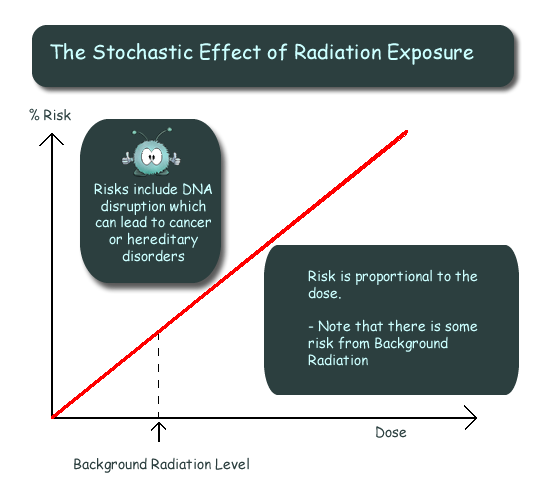
 Stochastic effects have no threshold and increase linearly
with dose.
Stochastic effects have no threshold and increase linearly
with dose.
 All doses therefore have a stochastic risk attached to them.
All doses therefore have a stochastic risk attached to them.
 The risk of developing fatal cancer decreases with age
at irradiation - in part because the older person may die of other
causes before the cancer develops. Also because rapid cell division occurs
in growing youngsters, those genetically inclined towards fatal cancer
will probably contract it at an early age.
The risk of developing fatal cancer decreases with age
at irradiation - in part because the older person may die of other
causes before the cancer develops. Also because rapid cell division occurs
in growing youngsters, those genetically inclined towards fatal cancer
will probably contract it at an early age.
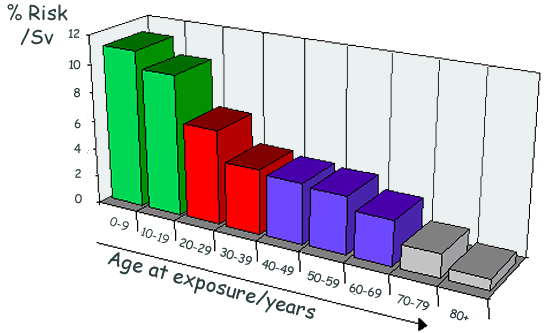
 The type of cancer causing death at various
ages also varies with age.
The type of cancer causing death at various
ages also varies with age.
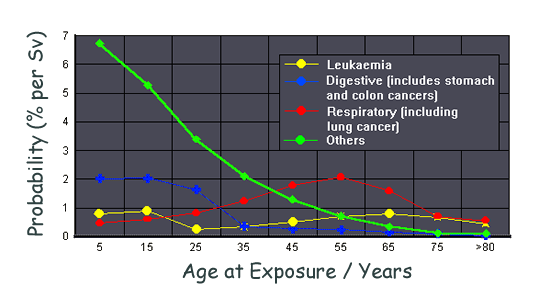
 Exposure to ionising radiation is therefore
strictly minimised by medical practicioners, especially for young children
and the unborn.
Exposure to ionising radiation is therefore
strictly minimised by medical practicioners, especially for young children
and the unborn.


